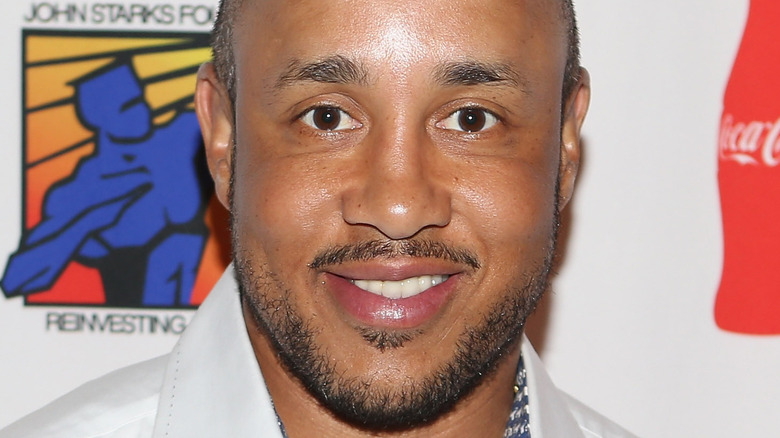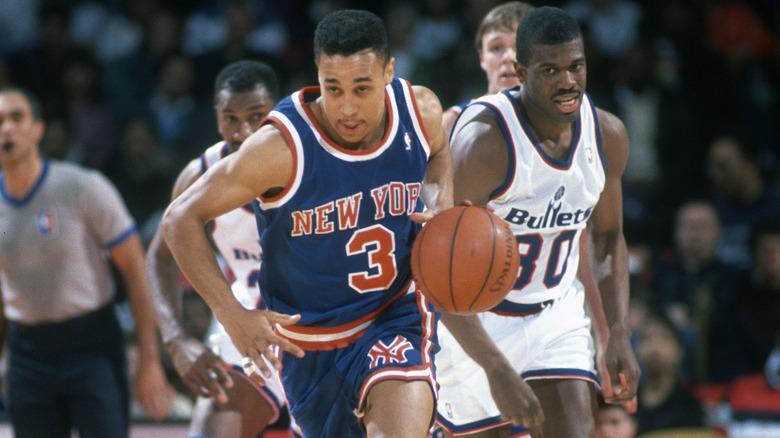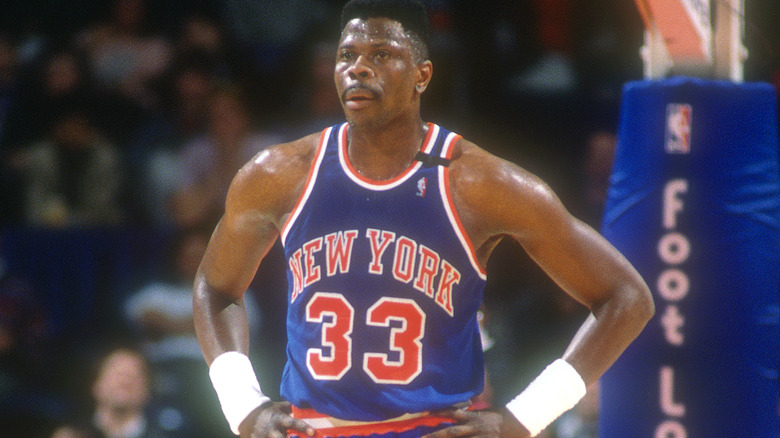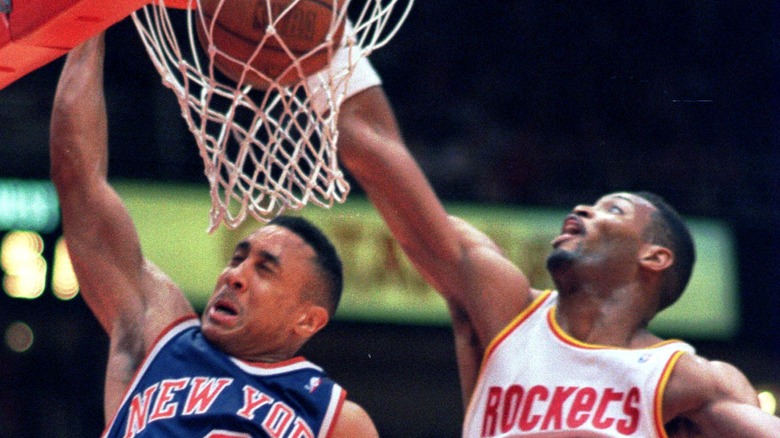New York Knicks Legend John Starks' Career Was Actually Saved By A Knee Injury
The 1990s New York Knicks were more than just Patrick Ewing's team. He may have been the franchise player, but he often had a more than capable supporting cast to work with, from muscular power forwards Charles Oakley and Anthony Mason to savvy backcourt veterans such as Doc Rivers and Derek Harper. Oakley and Mason handled the rebounding while Rivers and Harper were the aging, yet still capable point guards. Then you had John Starks, a tough-as-nails shooting guard who combined impressive athletic ability and outside shooting skills with strong playmaking. A look at their 1993-94 team page shows you much of what you need to know about Starks — he was second to Ewing in scoring on a club that went all the way to the NBA Finals, and he also led New York in assists and three-point shot attempts per game.
Taking all that into account, it's hard to believe Starks was once so far removed from any sort of NBA dream, an obscure player who studied in three colleges before playing his senior year at Oklahoma State (via The New York Times). Heck, his main reason for attending junior college after working for minimum wage as a grocer was to have a white-collar job, one where he'd go to work "[in] a jacket and a tie and an attache case." Obviously, he ended up playing pro basketball instead, and he might not have had the long career that he did if not for a knee injury he sustained in his early NBA years. Here's how it happened.
Starks entered the NBA as an undrafted free agent
One important thing to know about John Starks is that he was not picked by any NBA team during the 1988 draft, which, at the time, lasted three rounds and consisted of 75 picks. However, the former Oklahoma State star was able to attract the attention of the Golden State Warriors, who signed him ahead of the 1988-89 season. He didn't do much in limited playing time, averaging 4.1 points in 36 games with the Warriors before he was released in June 1989. What followed was a one-year stint in the minor leagues, where, per his NBA.com biography, he played for the Continental Basketball Association's Cedar Rapids Silver Bullets and the World Basketball League's Memphis Rockers.
Given this career trajectory, it would have been easy to assume that Starks would have a journeyman NBA run at best — like most undrafted free agents in their rookie year, he only put up modest numbers, and he was bouncing between minor leagues the very next season. In the lead-up to the 1990-91 season, Starks decided to give the big leagues another shot, trying out for the New York Knicks. Despite ostensibly looking like a long shot to join the Knicks, he would end up making the team — and staying much longer than anyone expected.
Starks injured his knee while trying to dunk over Patrick Ewing
Although the 1990-91 New York Knicks finished with an underwhelming 39-43 record, the team was not lacking for talent. Future Hall of Fame center Patrick Ewing (pictured above) was in his prime, and he had a solid supporting cast that featured forwards Charles Oakley and Kiki Vandeweghe, shooting guard Gerald Wilkins, and point guards (and future NBA head coaches) Mo Cheeks and Mark Jackson. This was the team John Starks joined when he signed his contract in October 1990, but his time as a Knick got off on the wrong foot, as he twisted his knee while trying to dunk on Ewing in practice.
Doing that took a lot of chutzpah, and apparently, Ewing wasn't too impressed by the sight of a relative nobody, a second-year backup guard fresh off the minor leagues, flexing his aerial ability on him. Per Bleacher Report, the 7-foot-tall center reacted by taking Starks down to the floor, which resulted in the young backcourt operator twisting his knee.
This was certainly not an ideal situation for Starks, but the NBA's rules prohibited teams from releasing players while injured — guess you can say they weren't allowed to literally add insult to injury. That meant New York had no choice but to hang on to Starks in the meantime. His hard work impressed the team so much that he was given quality minutes off the bench when he finally got healthy, and he didn't disappoint, averaging 7.6 points in close to 20 minutes per game as a second-string shooting guard behind Wilkins.
He became a starter for Pat Riley's 'Slowtime' Knicks
Following his decorated tenure with the Los Angeles Lakers, head coach Pat Riley's next stop was in New York, where he introduced Knicks fans to a slow-paced, physical brand of basketball that was nothing like the flash and dash the "Showtime" Lakers made so famous in the 1980s. This style has often been described as "Slowtime," and it was under Riley that Starks transformed from role player to super sixth man to starting two-guard, all in a few years' time. According to his Basketball-Reference page, Starks enjoyed his best statistical season in 1993-94, averaging 19 points, 3.1 rebounds, and 5.9 assists and playing in his first — and only — NBA All-Star Game.
As pointed out by Bleacher Report, Starks' career ups and downs were more spectacular than most, as he helped the Knicks to victory against the Chicago Bulls in Game 2 of the 1993 Eastern Conference Finals with an emphatic dunk on no less than Michael Jordan himself. However, his crunchtime heroics were nowhere to be seen just one year later, when he shot 2-for-18 from the field and 0-for-11 from three-point range in Game 7 of the 1994 NBA Finals against the Houston Rockets. The Knicks lost that game and once again failed in their quest to win their first NBA championship since the 1970s.
That all said, Starks probably wouldn't have had such a chance to prove his worth to the Knicks had he not suffered that fateful knee injury back in 1990. The Knicks could have potentially cut him if he remained healthy (via The New York Times) but instead, Starks ended up playing 13 seasons in a successful career that also included a second, more productive run with the Golden State Warriors, as well as stints with the Chicago Bulls and Utah Jazz.



